Sensor Sweep: Esteban Maroto, Greyhawk, Girl-boss Fatigue
Monday , 30, June 2025 Sensor Sweep Leave a commentComic Books (Dark Worlds Quarterly): Esteban Maroto made a splash in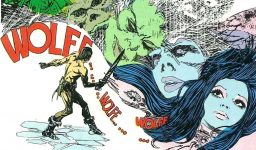 America when he drew Red Sonja in a steel bikini for Marvel then “Dax the Damned’ series for Warren Publications. Maroto would draw many other comics for the black & white publisher but he caught fire with Dax. This opulent but depressing series began in Spain in People and was called “Manly el Guerrero” or “Manly the Warrior”. Translated into English, he became Dax for Eerie #39, April 1972.
America when he drew Red Sonja in a steel bikini for Marvel then “Dax the Damned’ series for Warren Publications. Maroto would draw many other comics for the black & white publisher but he caught fire with Dax. This opulent but depressing series began in Spain in People and was called “Manly el Guerrero” or “Manly the Warrior”. Translated into English, he became Dax for Eerie #39, April 1972.
Robert E. Howard (Walker’s Library): Four years doesn’t seem like a lot of time, until you consider that this was the days of the Pulps and writing for them—if you got in with an editor—could (and for a few, did) mean earning a serious income. The cost was that it was a job like any other, so Howard treated it like one; he wasn’t an Artiste- he became a master Craftsman.
Cinema (Nerdrotic): Ironheart Is an Iconic DISASTER. Everyone hates Ironheart, and so do I. The worst live action Marvel ever made. Read More
Science Fiction and Fantasy New Releases: 28 June 2025
Sunday , 29, June 2025 Uncategorized 1 CommentEvery week, the Castalia House Blog spotlights some of the many new releases in independent, pulp, and web novel-influenced science fiction and fantasy.
When Nil gets hit hard, he hits back even harder.
Nil’s done it. He’s ascended from mundane life, he has joined a ludus, and made it through Apocalypse Arena’s qualifiers but it’s only the beginning.
If Lukas wants to protect his family and bring the people who ruined his life to justice, he needs to grow much stronger much faster. Climbing the ranks using the ordinary paths is much too slow and the longer he takes the more innocent lives will be at risk.
A terrifying option looms over him: Death Gauntlet. Where two fighters and a monster enter and only one walks out. Nil doesn’t want the needless risk. However, opponents calling themselves gods are targeting his friends, and he might just need to put them down.
It’s always darkest before dawn.
Lost Town is being rebuilt in the wake of tragedy. With no connection to Earth for three months, Caesar has the chance to regroup and determine the threat level from Lithos.
John can’t shake the sensation that the worst is yet to come, and it’s confirmed when Anders and Haley leave to investigate a potential second alien tower on Arcadia.
While Harrison takes a step back, Amelia must keep the peace between the rogue agents who are putting their mission in danger.
Meanwhile on Earth, Summer is contacted by a mysterious stranger who predicts a looming invasion.
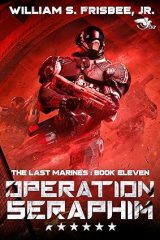 Operation Seraphim (The Last Marines #11) – William S. Frisbee, Jr.
Operation Seraphim (The Last Marines #11) – William S. Frisbee, Jr.
With Emperor Mathison in stasis and the empire struggling against the vanhat, humanity’s last hope is a desperate expedition to the galactic core. Their mission: find an ancient race powerful enough to save humanity from extinction.
But when Major Zale Stathis’s recon mission to the massive city-ship Bifrost goes catastrophically wrong, his team becomes trapped aboard a vessel controlled by the vanhat. Meanwhile, Admiral Diamond Winters must navigate the damaged Musashi through hostile space, hunted by both the vanhat and the machine intelligences of the Collective that remain just a step behind.
The odds are a million-to-one, but Stathis must find a way to escape—and perhaps even seize control of the homestar’s navigation systems. But time is running out as the vanhat Jotun Shroggath prepares to use Bifrost for another genocidal attack.
In this pulse-pounding continuation of The Last Marines military sci-fi saga, humanity walks the razor’s edge between survival and extinction, where valor and determination may be the only weapons capable of turning the tide against the overwhelming odds. Read More
Review (DMR Books): Willard ‘Will’ Oliver’s Robert E. Howard: The Life and Times of a Texas Author has been out for a couple of months now. I have read it. It is excellent. Now that I (hopefully) have Internet connectivity that allows more than an hour of online work every few days, I’m going to post my review.
Science Fiction (Fandom Pulse): Screen Rant has reached a new low in its desperate quest for engagement by publishing an article that tells readers to avoid some of science fiction’s most celebrated and influential works. Under the guise of helping newcomers to the genre, the entertainment website has crafted a hit piece against literary classics that have shaped modern science fiction, Read More
Science Fiction and Fantasy New Releases: 21 June 2025
Saturday , 21, June 2025 Uncategorized 1 CommentEvery week, the Castalia House Blog spotlights some of the many new releases in independent, pulp, and web novel-influenced science fiction and fantasy.
Tales of thrilling adventure and daring suspense that include:
A young man born in the arena lives only to fight! When a plot to overthrow the Emperor fails, the daughter of one of the traitors is hidden as a slave in his ludus!
Having delivered sacrificial horses to the King of Pergamos, Melkart intercedes on behalf of an insolent youth! Now, he must deliver the underworld offering himself!
While on his way to Rome to petition the Emperor, Raskos meets a strongman who wishes him to help immortalize his feat of lifting a massive boulder over his head!
Tamarick and Fastrick pursue Zoor across Kalidoh! Meanwhile, Zoor seeks to signal his allies in hopes of preparing a massive ambush to destroy the Wild Stars!
She was trained to break magic. Now she must uncover the power no one ever taught her to wield.
Ellie serves as King Dorian’s secret weapon—a Blade who can shatter even the strongest fabrications. But when her brother vanishes with knowledge that could unravel the kingdom, Ellie uncovers a deeper truth: her ability to destroy magic is only the beginning.
Hunted by a man who shares her forbidden gift and haunted by powers she was taught to fear, Ellie follows a trail that leads to a ruined city pulsing with lost magic and buried lies. There, among ancient fabrications and whispers of fae, she discovers that breaking magic isn’t her greatest threat—it’s what lies beneath it.
Torn between duty to the king and a legacy hidden even from her mentors, Ellie must decide what she’s willing to risk to save her brother—and whether the truth is worth the cost.
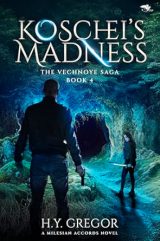 Koschei’s Madness (The Vechnoye Saga #4) – H. Y. Gregor
Koschei’s Madness (The Vechnoye Saga #4) – H. Y. Gregor
After she vanquished the Black God, Niki Baird wanted nothing more than to go back to a normal life. Those plans are shattered, though, when women begin going missing again, and all signs point to Koschei the Deathless, an ancient sorcerer who’d masqueraded as Niki’s friend and mentor.
When Crypto Division, a grieving warrior, and a cursed fae come knocking at Niki’s door, they all want the same thing: open the legendary chest of Koschei, shatter the needle inside, free a cursed city, and vanquish Koschei once and for all. Together with Ryan, Eanraig, and an increasingly strange and uncertain host of allies, Niki must track down the three keys and unravel the riddle to open the chest.
Destroying the piece of Koschei’s soul sealed inside is the only way to end his madness, and there will be no stopping him if he reaches it before they do.
To survive, he must master the skills of monsters.
Craig’s goal is a simple one: complete the World-level quest given to him by Daimon, the mysterious immortal with the power to halt the progress of time. While his world remains in limbo, an instant away from total annihilation, Craig must tackle the challenges set forth by the quest.
With nearly two centuries of experience under his belt, it should be easy. If only he were competing against himself.
Marsh, his most bitter rival, has been sent to this world as well and given the same quest.
In the end, only one can win. Craig’s path forward will be as it always has, through cunning, strength, and the mastery of every aspect of battle and survival.
With Toby, his world Guide at his side, Craig sets out to do what no one in the history of Odayn has accomplished: learn the skills of monsters and use them to his advantage.
Sensor Sweep: Brom, Charles Beaumont, Celtic Adventures
Monday , 16, June 2025 Sensor Sweep Leave a commentArt (Art of the Genre): Tim Kask (heal quickly man!) once let me know with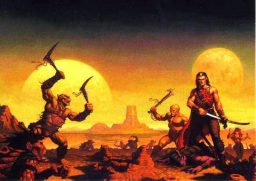 both barrels just how hard it was to get fantasy artists in the 1970s for the likes of Dragon Magazine, because basically there weren’t such an animal. Contrast that with today, and you can’t walk your fingers an inch over a keyboard without tripping over one on social media.
both barrels just how hard it was to get fantasy artists in the 1970s for the likes of Dragon Magazine, because basically there weren’t such an animal. Contrast that with today, and you can’t walk your fingers an inch over a keyboard without tripping over one on social media.
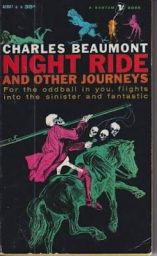 Fiction (Paperback Warrior): Before a rare illness took his life at the young age of 38, Charles Beaumont (1929-1967) put his mark on the science-fiction, fantasy, and horror genres with his splendid short stories and screenplays. His short fiction tale “Black Country” was the first story selected by Playboy to be published in their magazine.
Fiction (Paperback Warrior): Before a rare illness took his life at the young age of 38, Charles Beaumont (1929-1967) put his mark on the science-fiction, fantasy, and horror genres with his splendid short stories and screenplays. His short fiction tale “Black Country” was the first story selected by Playboy to be published in their magazine.
Biography (Frontier Partisans): They are gathering in Cross Plains, Texas, this weekend, for the annual Howard Days celebration of the great Texas pulp writer — a man whose short, incandescent arc across the literary firmament has inspired countless people to seek adventure on the page. Read More
Sensor Sweep: Weird Tales, Lin Carter, Pin Ball Machines
Monday , 9, June 2025 Sensor Sweep 2 CommentsFantasy (Dark Worlds Quarterly): Continuing our series of Sword & Sorcery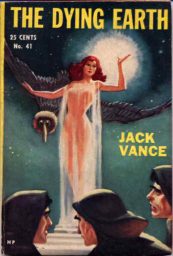 Firsts we are technically still in the Pulp Era until 1954 or so a few of the following happened in a Pulp magazine. The Digests take over shortly thereafter. Fantasy Fiction as a whole, whether it is S&S or not, has faded from much of the magazines, being replaced by Science Fiction. In some cases, S&S tales take on a Sci-Fi look to become Sword & Planet.
Firsts we are technically still in the Pulp Era until 1954 or so a few of the following happened in a Pulp magazine. The Digests take over shortly thereafter. Fantasy Fiction as a whole, whether it is S&S or not, has faded from much of the magazines, being replaced by Science Fiction. In some cases, S&S tales take on a Sci-Fi look to become Sword & Planet.
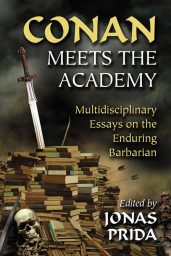 Literary Criticism (Arkhaven Comics): I mentioned last week the concept of academic wankery. This book is an excellent example. Conan Meets the Academy (McFarland, 2013), trade paperback, 216 pages, edited by Jonas Prida.
Literary Criticism (Arkhaven Comics): I mentioned last week the concept of academic wankery. This book is an excellent example. Conan Meets the Academy (McFarland, 2013), trade paperback, 216 pages, edited by Jonas Prida.
Conan (Paperback Warrior): Conan the Usurper was published in 1967 by Lancer with a painted cover by Frank Frazetta. It was later reprinted by Ace once Lancer ceased publishing operations. The book includes an introduction by L. Sprague de Camp and two short stories solely authored by Robert E. Howard. There are two additional stories included that were manuscripts by Howard that de Camp took it upon himself to edit and complete. Read More
Science Fiction and Fantasy New Releases: 7 June 2025
Saturday , 7, June 2025 Uncategorized Leave a commentEvery week, the Castalia House Blog spotlights some of the many new releases in independent, pulp, and web novel-influenced science fiction and fantasy.
Thomas has faced impossible odds since becoming Excalibur’s captain. His greatest challenge still lies ahead.
The line between hope and destruction has never been thinner.
When an unexpected ally brings Thomas and his battle-worn crew back from the brink of defeat, they find themselves racing against time, desperate to return to the fight before the Draconite can strike a final, devastating blow.
Meanwhile, the threat to Avalon continues to evolve. Armed with an ancient and terrible power, Turquine plans to bring the galaxy to its knees. Not in Morgana’s name, but in his own.
Two dragons will rise, but one must fall.
An ancient sorcerer. A malevolent plot. Can Caina see the trap before it is too late?
The serpent men seek to conquer the world, but Caina wants to banish them first.
If she can find a way to destroy the Liminal Temple, she can cut off the serpent men from her world and win a final victory.
But in the shadows, an ancient sorcerer of the orcs is stirring, preparing mighty spells that neither Caina nor the serpent men can foresee.
And all this sorcerer needs to finish his work is Caina’s blood…
A covert weapons test. A sabotaged mission. A spy wearing the face of a lover.
When the Iron Syndicate seizes control of a remote mining colony, AJ—former Earth Marine turned galactic operative—is sent in with his elite strike team to stabilize the situation. But the mission goes sideways fast. Bad intel, ambushed troops, and a devastating new energy weapon leave AJ scrambling to survive, let alone win. The real shock comes when he learns the occupation isn’t just a raid—it’s a live-fire trial of an experimental device capable of vaporizing whole squads in an instant.
The Syndicate plans to auction the weapon to the highest bidder, and AJ’s only shot at stopping them means infiltrating the very warship ferrying it across the stars. Behind enemy lines and alone, AJ must navigate the bowels of a hostile vessel where secrets run deep, betrayal is currency, and discovery means death. His objective is clear: find the scientist behind the weapon, sabotage production, and uncover the buyer before the deal is sealed.
But one familiar face changes everything. Lamia—once a lover, now a wildcard—is working with the enemy. Or is she? As AJ digs deeper into the conspiracy, he’s forced to question everything: her role, her loyalties, and his own.
Pulp (Comics Radio): We come to the last work of prose fiction in the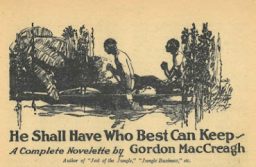 January 10, 1926 issue of Adventure. This one is a novella titled “He Shall Have Best Who Can Keep,” by Gordon MacCreath.
January 10, 1926 issue of Adventure. This one is a novella titled “He Shall Have Best Who Can Keep,” by Gordon MacCreath.
Writing (Kairos): Breaking Bad distinguishes itself from most modern storytelling in many respects, not least of which being its deliberate use of color. These days, in the rare instances when writers and directors treat color as anything more than an afterthought, it’s used as blunt, on-the-nose symbolism.
Fantasy (Arkhaven Comics): “With a panel of leading fantasy authors—N.K. Jemisin, Neil Gaiman, Sabaa Tahir, Tomi Adeyemi, Diana Gabaldon, George R.R. Martin, Cassandra Clare and Marlon James—TIME presents the most engaging, inventive and influential works of fantasy fiction, in chronological order beginning in the 9th century”
Pulp (Dark Worlds Quarterly): August Derleth keeps pumping out the short short stories for Weird Tales in 1928. Eight of them (and nary an illustration!) shows that Farnsworth Wright saw potential in this guys from Wisconsin and his collaboration partners. There are a few unusual moments amongst these traditional and somewhat predictable tales. One tale shows Derleth moving closer to writing in the Lovecraftian mode.
Technology (Contemplations on the Tree of Woe): There are only three kinds of people in the world now: AI evangelists, AI skeptics, and AI doomers. The evangelists are the true believers. They think artificial general intelligence is coming fast: ten years, five years, maybe less. When it arrives, it will be the greatest force multiplier in human history
Interview (Black Gate): Jason M. Waltz has published 16 Books under Rogue Blades Entertainment (RBE), another 3 under Rogue Blades Foundation (RBF), having lured in authors Such as Brandon Sanderson, Orson Scott Card, C.L. Werner, Glen Cook, Steven Erikson, Ian C. Esslemont, William King, Andy Offutt, and spurred the writing careers of dozens. Not all are Sword and Sorcery (S&S), with weird western and pirate anthologies appearing, but most are.
Blades Entertainment (RBE), another 3 under Rogue Blades Foundation (RBF), having lured in authors Such as Brandon Sanderson, Orson Scott Card, C.L. Werner, Glen Cook, Steven Erikson, Ian C. Esslemont, William King, Andy Offutt, and spurred the writing careers of dozens. Not all are Sword and Sorcery (S&S), with weird western and pirate anthologies appearing, but most are.
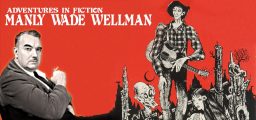 Authors (Goodman Games): Manly Wade Wellman arrived in this world on May 21st, 1903, born literally an ocean away from the place he’d be forever associated with in his later life. Young Manly’s playground was the land of Portuguese West Africa (now Angola), where his father was stationed as a medical officer.
Authors (Goodman Games): Manly Wade Wellman arrived in this world on May 21st, 1903, born literally an ocean away from the place he’d be forever associated with in his later life. Young Manly’s playground was the land of Portuguese West Africa (now Angola), where his father was stationed as a medical officer.
Fantasy (Silver Key): John Steinbeck is rightly remembered these days as a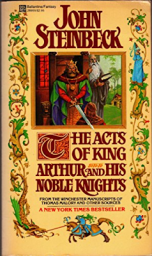 Pulitzer-prize winning author of The Grapes of Wrath and secondarily, East of Eden; almost no one talks about his foray into Arthurian myth.
Pulitzer-prize winning author of The Grapes of Wrath and secondarily, East of Eden; almost no one talks about his foray into Arthurian myth.
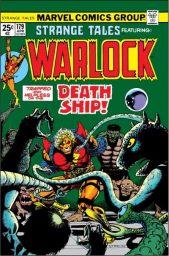 Comic Books (50 Year Old Comics): Last November, we took a look at Strange Tales #178, featuring the premiere installment of Marvel Comics’ revived “Warlock” feature, now written and drawn by Jim Starlin. In the first episode of a new multi-part storyline, the one-time savior of Counter-Earth learned for the first time of the galactic-level threat represented by the Universal Church of Truth
Comic Books (50 Year Old Comics): Last November, we took a look at Strange Tales #178, featuring the premiere installment of Marvel Comics’ revived “Warlock” feature, now written and drawn by Jim Starlin. In the first episode of a new multi-part storyline, the one-time savior of Counter-Earth learned for the first time of the galactic-level threat represented by the Universal Church of Truth
Western (Fifties Westerns): Starring Clint Eastwood, Inger Stevens, Ed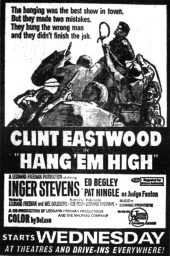 Begley, Pat Hingle, Ben Johnson, Charles McGraw, Bruce Dern, Dennis Hopper, James McArthur, Bob Steele
Begley, Pat Hingle, Ben Johnson, Charles McGraw, Bruce Dern, Dennis Hopper, James McArthur, Bob Steele
I’m really excited about this one. In July, ViaVision is releasing a new Blu-Ray of Hang ‘Em High (1968), Clint Eastwood’s first film after his three Italian Westerns with Sergio Leone.
Fiction (Ken Lizzi): Rosemary Sutcliff had vision. Not only did she have vision, but she could share it with her readers. She could immerse us in detail, not only of the natural world, with the facility of Tolkien, but in period detail such clothing or architecture. And she did so with a seamless facility; nothing feels forced or awkwardly shoehorned into place to artificially provide color and verisimilitude. The Eagle of the Ninth is an excellent example
Popular Culture (Book Steve’s Library): The Shmoo was created by Al Capp more than 75 years ago and it’s impossible to really get across to anyone who wasn’t there just what a phenomenon the characters turned out to be. They re-appeared off and on well into the 1960s and even ended up with a Saturday morning cartoon in the mid-70s. As the last article here attests, though, the Shmoo was all but forgotten by 2001.
Illustration (John Coulthart): You won’t find Harry Clarke’s illustration for Swinburne’s Aholibah in Selected Poems of Algernon Charles Swinburne even though it was intended for the book, and was the illustration that Clarke deemed his favourite of the series. The erotic nature of the drawing was too much for the publisher.
T.V. (Twilight Zone Vortex): “Ring-a-Ding Girl” Season Five, Episode 133 Original Air Date: December 27, 1963 Cast:Barbara “Bunny” Blake: Maggie McNamara Hildy Powell: Mary Munday
Original Air Date: December 27, 1963 Cast:Barbara “Bunny” Blake: Maggie McNamara Hildy Powell: Mary Munday
Bud Powell: David Macklin
Fiction (Old Style Tales): Automobiles quickly became yet another one of Doyle’s pet hobbies when they began to increase in speed and power, and in 1911 he was celebrated for his participation in an international car race wherein he and his wife piloted one of the cars to lead the British team in victory against the Germans (led by a Prussian crown prince, no less).
Weird Tales (M Porcius): Here we have the last issue of Weird Tales edited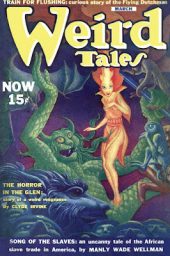 by Farnsworth Wright, an issue with a colorful Hannes Bok cover. In the letters column, Ray Bradbury speaks at length on the greatness of Bok and brings to our attention Bok’s relationship with Maxfield Parrish, a guy whose prints fill the antique stores my wife and I frequent.
by Farnsworth Wright, an issue with a colorful Hannes Bok cover. In the letters column, Ray Bradbury speaks at length on the greatness of Bok and brings to our attention Bok’s relationship with Maxfield Parrish, a guy whose prints fill the antique stores my wife and I frequent.
Writers (John Coulthart): The full title of this BBC documentary is Down These Mean Streets a Man Must Go: A Portrait of Raymond Chandler. The film was broadcast in 1969, ten years after Chandler’s death, and has been on iPlayer recently to judge by the logo in the corner, but it’s not one I’d seen before. It would have been ideal viewing a couple of years ago during my attempt to watch all the films listed in The Big Noir Book.
Review (Paperback Warrior): The Men’s Adventure Quarterly Magazine are highlights of my year. Thankfully, the boys behind this amazing publication put in the hard work and are dedicated to keep these books coming. This is the quarterly magazine edited by both Robert Deis and Bill Cunningham that focuses on vintage men’s action-adventure magazines, but delves into other media like paperbacks, comics, films, and books about books. Guest contributors in this issue are James Reasoner, David Avallone, John Harrison, David Spencer, and Paul Bishop.
Reading (Imperium Press): One of our most requested reading lists is a list for male self-improvement. Whether improving your body, mind, skills, or worldview, in this video we’ll give you the books that can turn good men into great men.
Radio (Old Time Radio Researcher Group): Dark Fantasy – Single Episodes
History (Raymond Ibrahim): Today in history, the important fortress city of Acre fell back to Crusader hands, and in so doing ushered in the Third Crusade—the most bloody and violent of all Crusades. And its chief architect—a man hated but also greatly respected by his Muslim adversaries—was King Richard I, the Lionheart.
Science Fiction and Fantasy New Releases: 31 May 2025
Sunday , 1, June 2025 Uncategorized Leave a commentEvery week, the Castalia House Blog spotlights some of the many new releases in independent, pulp, and web novel-influenced science fiction and fantasy.
In the East is a land ruled by an emperor, whose consorts and serving women live in a sprawling complex known as the hougong, the rear palace. Maomao, an unassuming girl raised in an unassuming town by her apothecary father, never imagined the rear palace would have anything to do with her—until she was kidnapped and sold into service there.
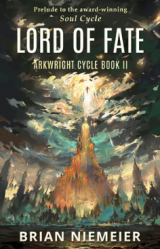 Lord of Fate (Arkwright Cycle #2) – Brian Niemeier
Lord of Fate (Arkwright Cycle #2) – Brian Niemeier
A holy warrior plagued by doubt …
A cloistered mystic yoked with rulership …
A fated prophet seeking the powers of life and death …
Besieged by a ruthless prince and a cruel legion, the free port of Dailij seems doomed.
Trapped in the embattled city and lionized by its desperate people, imperial envoy Zebrin finds his faith tested by their newly elevated queen. Spies and traitors seek to topple the walls from within. The quest for the Burned Book stands on the brink of failure.
To survive, Zebrin must discover his place in the prophecies reshaping the world. But when solving an ancient riddle of tragic love means choosing between his honor and his soul, will Zebrin find strength enough to save the fallen savior? Or will evils not of the world reign over it?
The choice lies with the Lord of Fate. Read More
This is a guest post from Deuce:
Manly Wade Wellman led a helluva life. Born in 1903 in what is now known as Angola, he was made the adopted son of a tribal chief thanks to his father’s medical expertise. Manly’s father was not only a doctor but also a published author and all-around man of parts. His parents moved to the USA when he was six. Wellman graduated college at Wichita State University in the great state of Kansas before making an unholy pilgrimage to Columbia University, where he earned another degree. MWW immediately set out on his chosen career as an author, having a story published in the November 1927 issue of Weird Tales.
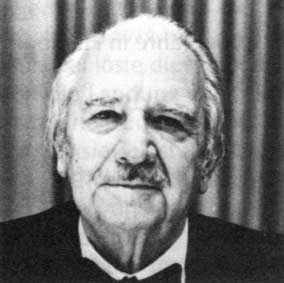
Wellman’s literary career would last over six decades. He was a true student of history, writing numerous non-fiction works and biographies. He also penned a multitude of fun SF tales, of which his “Hok the Mighty” stories might be my favorite. However, his fictional bread n’ butter was crafting yarns of occult detectives. First there was Judge Pursuivant, then John Thunstone and then, John the Balladeer.
John the Balladeer, whom MWW once called “a cross between John the Baptist and Johnny Cash”, dominates Wellman’s literary legacy. As Conan is to Robert E. Howard, so is John to Manly’s reputation among his fans.
However, Wellman loved writing Sword-and-Sorcery. His Thunstone tales are essentially a modern (1940s) version, with Thunstone using his “Dai sword” in supernatural combat more than once. Manly’s “Hok” tales are borderline. I class them as SF, since I recall no actual supernatural elements in them. If we are to believe MWW himself, he came up with the idea for his ‘Kardios the Atlantean’ tales for Weird Tales in the ’30s.
True or not, Kardios is how I first discovered Wellman’s fiction, specifically in Swords Against Darkness II. I soon read most of the Thunstone and Balladeer tales. Then I tracked down Manly’s Cahena: A Dream of the Past.
Cahena was published by Doubleday in hardcover a few months after MWW died. That was its only printing until DMR Books picked up the flickering torch and republished it in 2020.
Cahena is Wellman’s final novel. After decades of writing about occult detectives, far-flung space adventures and the American South, he decided to scribe a sword-and-sorcery novel about the Berbers’ struggle against Arab imperialists in the last decade of the seventh century.
Make no mistake: Cahena is a sword-and-sorcery novel. Historical sword-and-sorcery. Despite totally artificial limits set by those with agendas, Robert E. Howard’s Solomon Kane yarns are S&S. Period. As are yarns like “Worms of the Earth” and “The Gods of Bal-Sagoth”. Among the “First Dynasty” of S&S scribes, Clark Ashton Smith, C.L. Moore and Fritz Leiber all wrote ‘Historical Sword-and-Sorcery’ during the 1930s. I will defend this anywhere and anytime.
Cahena bridges the gap between the seventh and eighth centuries. There had been an initial wave of Arab Muslim conquerors–riding high off their conquest of formerly Christian Egypt–which had swept all the way to the Atlantic. However, resistance from the indigenous Christian Berber tribes had forced all that back to eastern Libya. Wulf the Saxon, a native of England, had been fighting for the Byzantine throne for almost a decade. He was among the troops that were sent to reinforce Carthage, which fell to the Mohammedans in 698 AD.

Wulf finds refuge among the Berber forces of the Cahena–a prophetess of supernal beauty. He tells them his bonafides:
“You’ve come far across the world,” Bhakrann [the Cahena’s captain] observed. “You escaped being killed by Moslems, then by us. Call yourself lucky.”
“Call yourselves lucky, too,” said Wulf at once, and Cham snorted, but again Bhakrann laughed.
Wulf then relates what happens when unbelievers fall into the hands of Allah’s Faithful:
He described the sack of the cities, men butchered, women screaming in hysterical terror, children herded away like sheep.
“They’re shipping those children to Damascus,” said Wulf.
This isn’t Wulf’s first rodeo. He has fought the rabid hordes of the Prophet (PBUH) all along Byzantium’s frontiers and seen what happens to those who lose. Possibly the deadliest swordsman in North Africa, Wulf has also studied the battles of Caesar and others. Both attributes bring him into the Cahena’s inner circle.
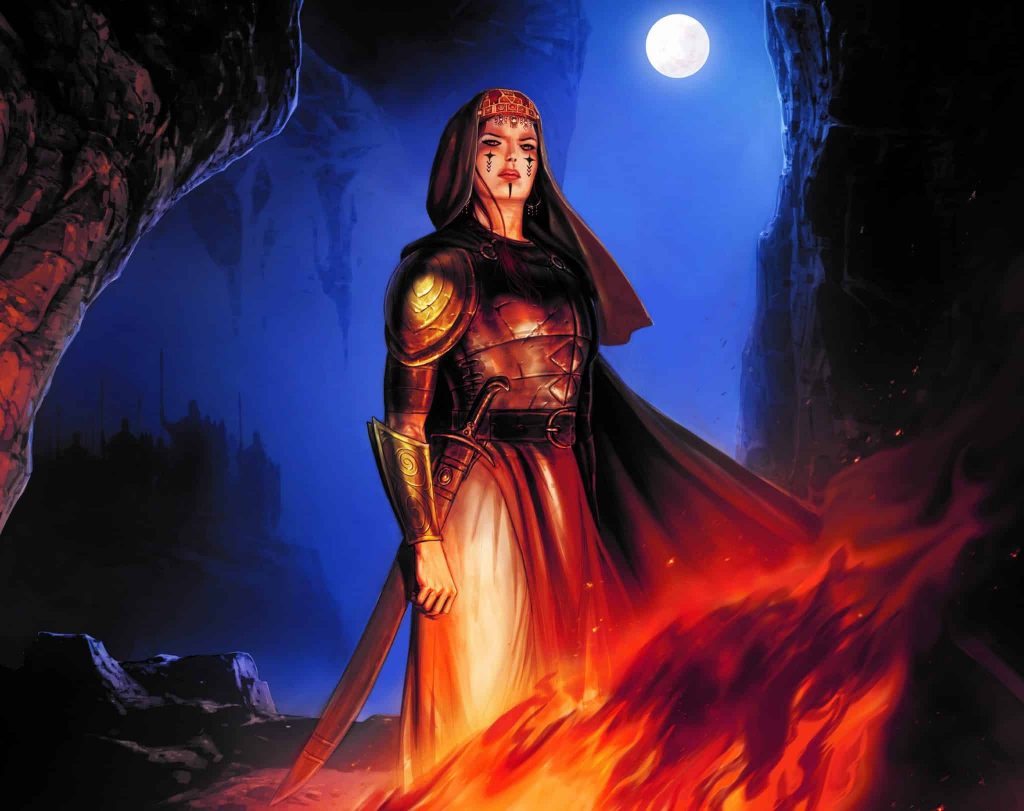
‘Cahena’ is another form of the Arabic Al-Kahina, which means prophetess/sorceress. Meant as an insult–like ‘Yankee Doodle Dandy’–the Berbers adopted it for her ‘outer name’. Her true name was reserved for her inner circle. The Cahena’s powers are real.
This brings up the ‘Sword-and-Sorcery’ classification of Cahena. The Cahena has objectively authentic supernatural powers of prophecy and clairvoyance (two different things, by the way). Also, Wulf kills what has to be a lamia-vampire in the course of the novel. Finally, there is the presence of the demon/war-god/death-god, Khro. That is a little murkier, but still convincing within the narrative.
Let me put this in very simplistic terms: there is far more ‘sorcery’/the supernatural in Cahena than there is in “Rogues in the House” or “Swords of the Purple Kingdom”. And yet, the latter yarns are totally considered ‘canonical’ S&S and Cahena is just/simply/merely ‘historical fantasy’. Quit beclowning yourselves, Poindexters. For your own sakes.
I won’t toss out any more spoilers, but here’s an excerpt from one battle:
He lifted his sword high and urged his war horse forward. Spear men fell away to right and left before him, running to find their own mounts and join the counterattack. A wordless howl beat up from the men riding behind Wulf. He saw Uchia on foot to one side, and even as Wulf saw him Uchia went down under the frantic blow of a Moslem scimitar. Riding in, Wulf sped a swift slash and down went the slayer, across Uchia’s body.
Wulf put his horse to a mighty jump over two chargers that struggled in crippled pain on the ground, and drove in among the discomfited Moslems beyond.
Blood n’ thunder stuff! There was a rumor at one point that Karl Edward Wagner “helped” MWW with those battle scenes. David Drake — a man who would know — categorically shot that down. This is Wellman at the peak of his narrative powers.
Cahena: A Dream of the Past is Manly Wade Wellman’s final, epic triumph in a career with plenty of milestones. He had already won/earned the World Fantasy Convention’s ‘Lifetime Achievement Award’ in 1980 and had nothing to prove.
I have read the vast majority of MWW’s novels. Cahena stands above all the rest. Put aside the fact that any John the Balladeer novel was just another ‘Conanic episode’ in the hero’s career–as fun as that might be–Cahena simply contains more emotional depth and resonance. I’ve read all the Balladeer novels and have never reread any of them. Despite starting a decade later, I’ve reread Cahena four times.
DMR Books republished Cahena: A Dream of the Past–for the first time ever–in 2020. That license runs out in a few days, on June 1. It may be another forty years–or never–before a publisher takes a chance on a ‘dead tree’ edition. Grab a copy while you can. Order it here.
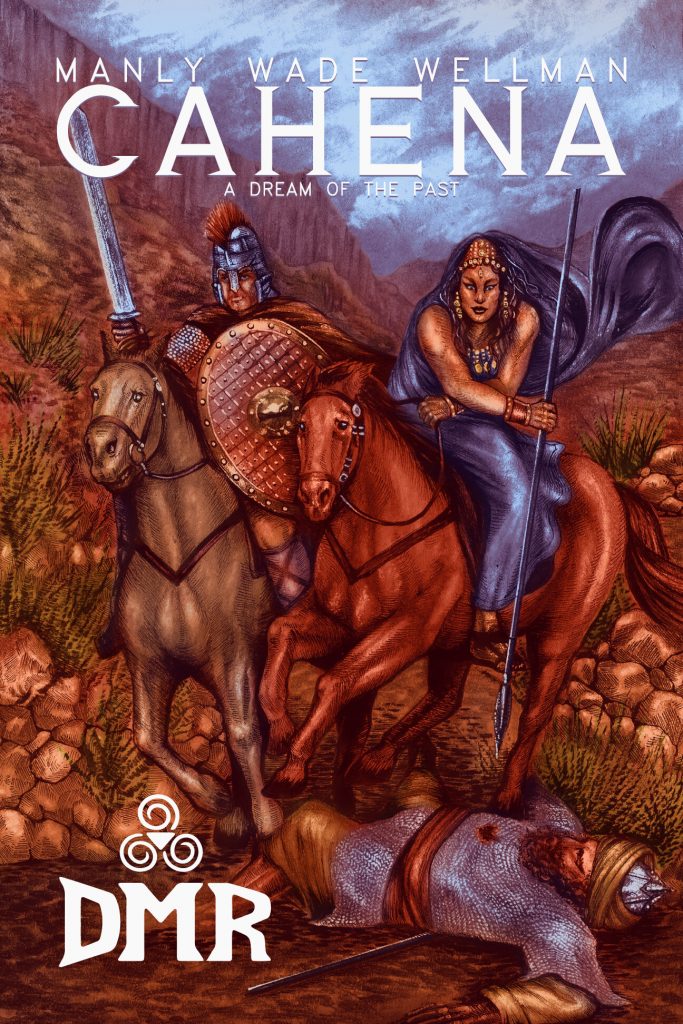
Sensor Sweep: Lovecraft Manga, Manly Wade Wellman, D.C. Comics
Monday , 26, May 2025 Sensor Sweep Leave a commentWeird Westerns (Crime Reads): The weird western is nothing new. Since at least 1932, with Robert E. Howard’s “The Horror from the Mound,” writers have been combining fantasy, science-fiction, and horror with the Old West in novels, stories, comics, and films. The genre built to a crescendo in the 1980s. The last major iteration I can remember is the 2011 movie Cowboys & Aliens.
Fiction (Frontier Partisans): Since I was a tweener, I have been a fan of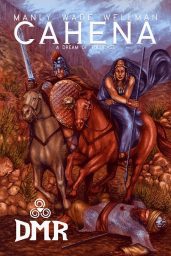 Manly Wade Wellman. Initially, it was his tales of Kardios in the Swords Against Darkness anthologies. However, I soon began tracking down his yarns regarding John the Balladeer. Since then, I’ve read the vast majority of MWW’s SF/fantasy/horror novels. Manly’s final novel was Cahena.
Manly Wade Wellman. Initially, it was his tales of Kardios in the Swords Against Darkness anthologies. However, I soon began tracking down his yarns regarding John the Balladeer. Since then, I’ve read the vast majority of MWW’s SF/fantasy/horror novels. Manly’s final novel was Cahena.
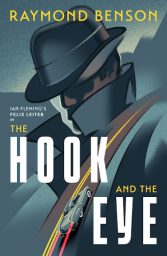 James Bond (Book Bond): Cover art for Raymond Benson’s Felix Leiter spin-off adventure, The Hook and the Eye, has been revealed, and it’s pretty slick! The eBook serialization begins May 27th. The novel will be released in paperback in October. Read More
James Bond (Book Bond): Cover art for Raymond Benson’s Felix Leiter spin-off adventure, The Hook and the Eye, has been revealed, and it’s pretty slick! The eBook serialization begins May 27th. The novel will be released in paperback in October. Read More
Every week, the Castalia House Blog spotlights some of the many new releases in independent, pulp, and web novel-influenced science fiction and fantasy.
Hell hath no Fury like a Dark Goddess
Life is good for Gathelaus, he won back his crown, his kingdom and his woman – too bad the dark goddess Boha-Annu hasn’t forgotten and is plotting her revenge.
She knows his weakness, his temptations and his obligations, she will use all of his strengths against him.
Nobody holds a grudge like a spurned Goddess…
There will be a Fire in the Bones!
A mysterious invite heralds the beginning of the Palace Royale, a new tournament that sees both friends and enemies pitted against each other.
Aurin, Luna and Kyle each receive invites to a brand new tournament at Lord Kensington’s palace, which the distinguished nobleman has named the Palace Royale. Dozens of competitors gather, with three Minakai apiece, and the last tamer with a Minakai still standing will be declared the victor and receive one of the greatest prizes known to man.
All the while, the Zodiac Squad elites have gathered in Hazelton, setting themselves up to enact their final plan. With time running out to stop them, Aurin and his friends are determined to squash the devious group once and for all. The only question is, can the tamers stand up to the might of the Zodiac Squad’s toughest monsters?
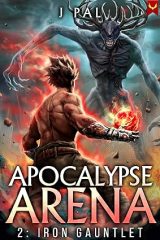 Apocalypse Arena #2: Iron Gauntlet
Apocalypse Arena #2: Iron Gauntlet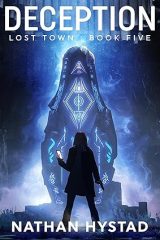 Deception
Deception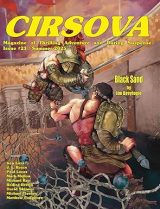 Cirsova Magazine #23 / Summer 2025
Cirsova Magazine #23 / Summer 2025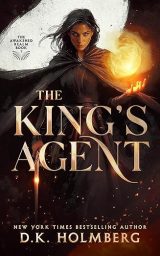 The King’s Agent
The King’s Agent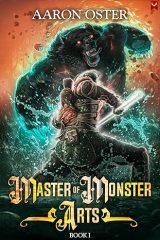 Master of Monster Arts
Master of Monster Arts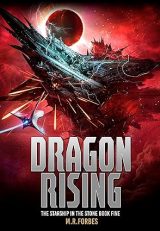 Dragon Rising
Dragon Rising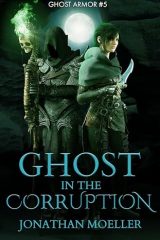 Ghost in the Corruption
Ghost in the Corruption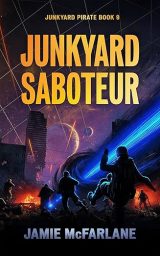 Junkyard Saboteur
Junkyard Saboteur The Apothecary Diaries #14
The Apothecary Diaries #14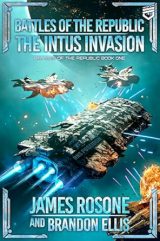 The Intus Invasion
The Intus Invasion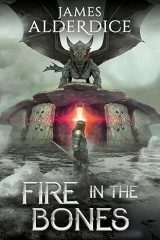 Fire in the Bones
Fire in the Bones Minakai: Monster Tamer #3
Minakai: Monster Tamer #3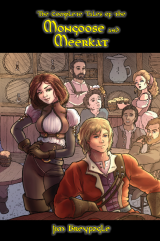 The Complete Tales of the Mongoose and Meerkat
The Complete Tales of the Mongoose and Meerkat